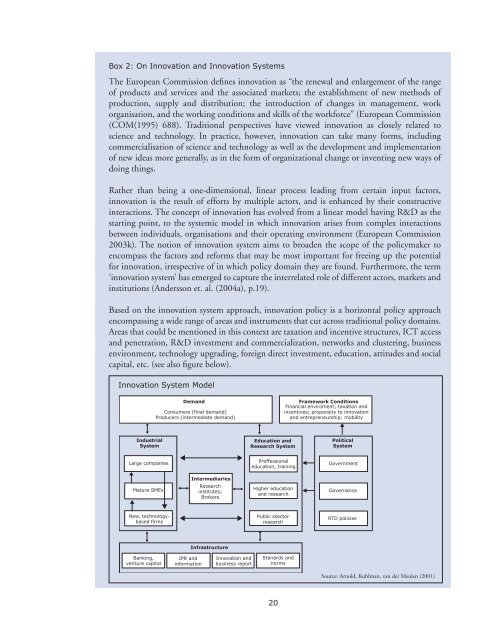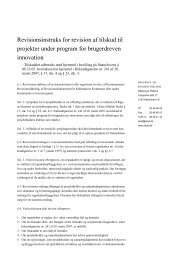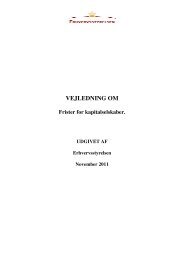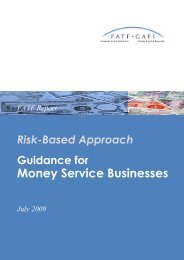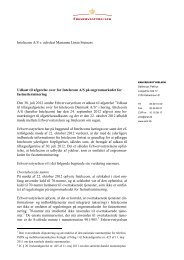Competing in the Single Market - SMEs and ... - Erhvervsstyrelsen
Competing in the Single Market - SMEs and ... - Erhvervsstyrelsen
Competing in the Single Market - SMEs and ... - Erhvervsstyrelsen
Create successful ePaper yourself
Turn your PDF publications into a flip-book with our unique Google optimized e-Paper software.
Box 2: On Innovation <strong>and</strong> Innovation SystemsThe European Commission def<strong>in</strong>es <strong>in</strong>novation as “<strong>the</strong> renewal <strong>and</strong> enlargement of <strong>the</strong> rangeof products <strong>and</strong> services <strong>and</strong> <strong>the</strong> associated markets; <strong>the</strong> establishment of new methods ofproduction, supply <strong>and</strong> distribution; <strong>the</strong> <strong>in</strong>troduction of changes <strong>in</strong> management, workorganisation, <strong>and</strong> <strong>the</strong> work<strong>in</strong>g conditions <strong>and</strong> skills of <strong>the</strong> workforce” (European Commission(COM(1995) 688). Traditional perspectives have viewed <strong>in</strong>novation as closely related toscience <strong>and</strong> technology. In practice, however, <strong>in</strong>novation can take many forms, <strong>in</strong>clud<strong>in</strong>gcommercialisation of science <strong>and</strong> technology as well as <strong>the</strong> development <strong>and</strong> implementationof new ideas more generally, as <strong>in</strong> <strong>the</strong> form of organizational change or <strong>in</strong>vent<strong>in</strong>g new ways ofdo<strong>in</strong>g th<strong>in</strong>gs.Ra<strong>the</strong>r than be<strong>in</strong>g a one-dimensional, l<strong>in</strong>ear process lead<strong>in</strong>g from certa<strong>in</strong> <strong>in</strong>put factors,<strong>in</strong>novation is <strong>the</strong> result of efforts by multiple actors, <strong>and</strong> is enhanced by <strong>the</strong>ir constructive<strong>in</strong>teractions. The concept of <strong>in</strong>novation has evolved from a l<strong>in</strong>ear model hav<strong>in</strong>g R&D as <strong>the</strong>start<strong>in</strong>g po<strong>in</strong>t, to <strong>the</strong> systemic model <strong>in</strong> which <strong>in</strong>novation arises from complex <strong>in</strong>teractionsbetween <strong>in</strong>dividuals, organisations <strong>and</strong> <strong>the</strong>ir operat<strong>in</strong>g environment (European Commission2003k). The notion of <strong>in</strong>novation system aims to broaden <strong>the</strong> scope of <strong>the</strong> policymaker toencompass <strong>the</strong> factors <strong>and</strong> reforms that may be most important for free<strong>in</strong>g up <strong>the</strong> potentialfor <strong>in</strong>novation, irrespective of <strong>in</strong> which policy doma<strong>in</strong> <strong>the</strong>y are found. Fur<strong>the</strong>rmore, <strong>the</strong> term‘<strong>in</strong>novation system’ has emerged to capture <strong>the</strong> <strong>in</strong>terrelated role of different actors, markets <strong>and</strong><strong>in</strong>stitutions (Andersson et. al. (2004a), p.19).Based on <strong>the</strong> <strong>in</strong>novation system approach, <strong>in</strong>novation policy is a horizontal policy approachencompass<strong>in</strong>g a wide range of areas <strong>and</strong> <strong>in</strong>struments that cut across traditional policy doma<strong>in</strong>s.Areas that could be mentioned <strong>in</strong> this context are taxation <strong>and</strong> <strong>in</strong>centive structures, ICT access<strong>and</strong> penetration, R&D <strong>in</strong>vestment <strong>and</strong> commercialization, networks <strong>and</strong> cluster<strong>in</strong>g, bus<strong>in</strong>essenvironment, technology upgrad<strong>in</strong>g, foreign direct <strong>in</strong>vestment, education, attitudes <strong>and</strong> socialcapital, etc. (see also figure below).Innovation System ModelDem<strong>and</strong>Consumers (f<strong>in</strong>al dem<strong>and</strong>)Producers (<strong>in</strong>termediate dem<strong>and</strong>)Framework ConditionsF<strong>in</strong>ancial enviroment; taxation <strong>and</strong><strong>in</strong>centives; propensity to <strong>in</strong>novation<strong>and</strong> entrepreneurship; mobilityIndustrialSystemEducation <strong>and</strong>Research SystemPoliticalSystemLarge companiesProffessionaleducation, tra<strong>in</strong><strong>in</strong>gGovernmentMature <strong>SMEs</strong>IntermediariesResearch<strong>in</strong>stitutes;BrokersHigher education<strong>and</strong> researchGovernanceNew, technologybasedfirmsPublic ssectorresearchRTD policiesInfrastructureBank<strong>in</strong>g,venture capitalIPR <strong>and</strong><strong>in</strong>formationInnovation <strong>and</strong>bus<strong>in</strong>ess reportStanards <strong>and</strong>normsSource: Arnold, Kuhlman, van der Meulen (2001)20


